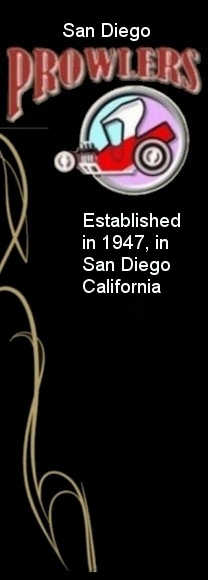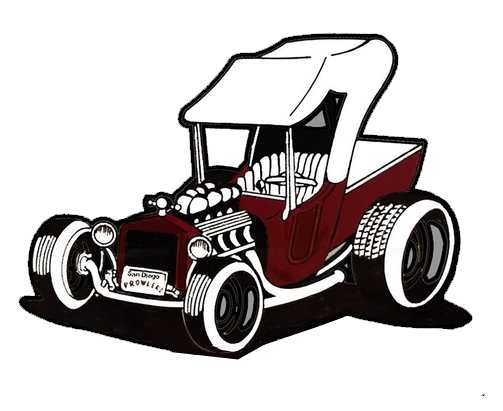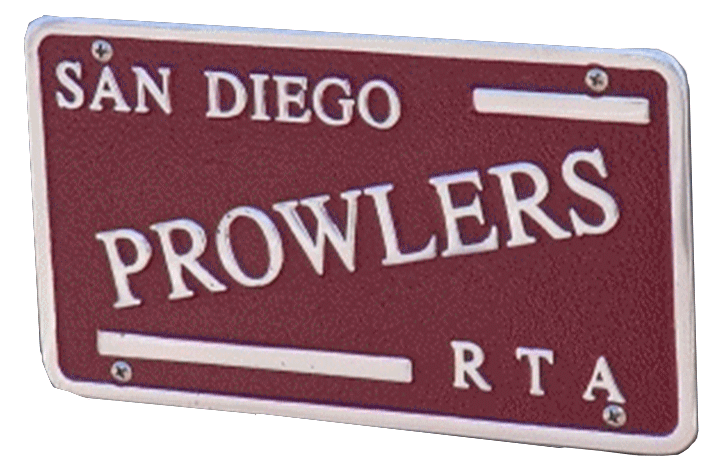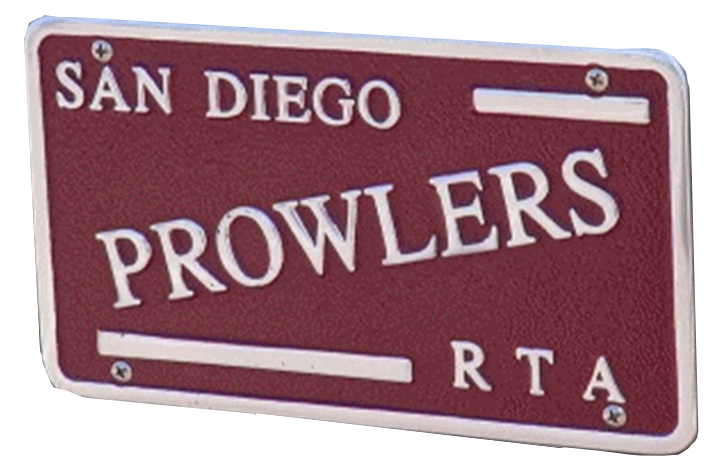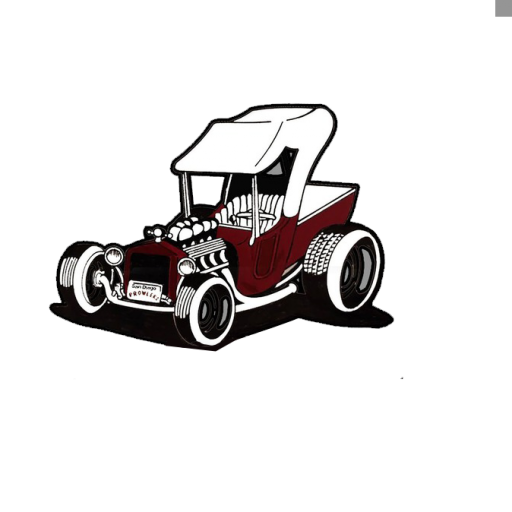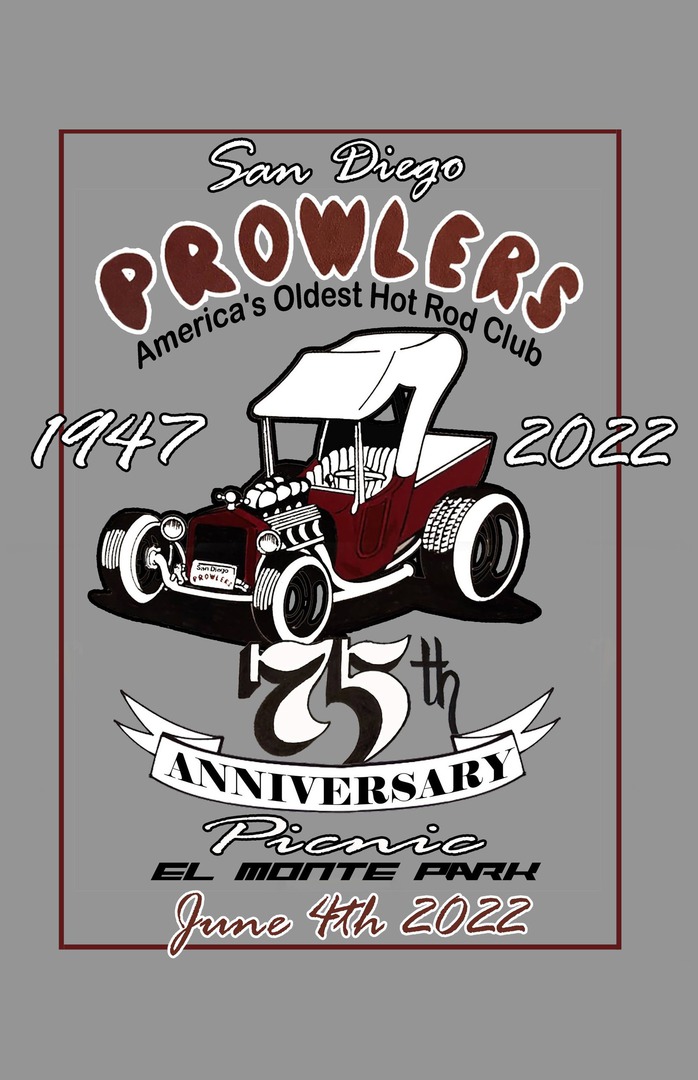Bob Stewart Prowlers Member of Dago Axle
The Stewart Roadster-The Story
The Stewart roadster is a classically definitive Southern California Deuce from the post-war era of hot rodding.With all the handles shaved and the door hinges faired into the cowl . it was a cut above the average nice Deuce in it’s day. Making it extra special was it’s front axle—not the only example on the streets and lakes to be sure, but one that signaled the start of a trend that would become an integral part of the classic form that was to emerge.
Ed Stewart had established himself as a serious hot rodder long before he built the Deuce, modifying a tidy ’29 A-V8 first with a fettered four-banger and then with a proper V8 in the ’30s and on through the war years.
Ed sold the ’29 after the war and bought his wife a fur coat. It was a diversion, son Bob says; Ed had been collecting parts for the roadster in the meantime, including a body he plucked from a field and then deposited at Johnny Vesco’s shop for repairs and hole filling. It was doubtful that Mrs. Stewart would have been as excited about a new roadster as were her husband and son.
Bob saw the roadster on the street the first time on his way home from school while riding the school bus. It was also the occasion of his first ride in the Deuce. “I was nine or ten at the time”, he says. “And I screamed at the bus driver to stop. He did and I jumped out of the bus and my dad picked me up!”
The roadster first ran at the lakes in 1946 and during that initial outing Ed let Bob drive it. “I was a pro after a few jack rabbit starts,” Bob recalls. “The car turned 98 that day.” For Bob, 11 at the time, the driving lesson and experience was a great confidence builder.
The roadster was driven on the streets in the early days as well as to the lakes, and around 1947 the Stewarts began flat-towing it out to the desert. It’s best performance was recorded on June 12, 1949 when it ran 138.46 at El Mirage. Interestingly, the roadster was never raced at or even visited Bonneville until 1992.
Ed drag raced with the roadster, with a flathead in the early ’50s and then with a Chevy V8 in the mid ’50s, retiring it when it exploded its Ford transmission.
The roadster is registered in Bob’s mother’s name with the title dating back to 1945, making it one of the oldest continuous-ownership hot rods in existance. Since Bob’s ressurection of the car, it’s building a new reputation under his stewardship, and while Bob speaks of the 30-year hiatus almost apologetically, he’s justifiably proud of how well it has turned out and how much its appearance is appreciated by those who knew it–and his father–way back when.
The roadster’s engine is a classic Ford/Mercury 59A, bored and stroked to 296 cubic inches, fitted with the very best of hardware that was available in 1948–Forgedtrue pistons, a Potvin 3/8 camshaft, rare Evans heads and a three pot manifold with three Stromberg 48 carburetors (“We were an Evans dealer in the ’50s,” says Bob), and original Belond headers–modified to fit around the Vega steering–connected to 28 inch glass packs. The right look is abetted by the Harmon-Collins magneto, but Bob confesses he has converted it to a distributor, using a mid-’70s Delco electronic ignition stuffed inside. “It just wouldn’t fire unless I was all by myself, if anyone else was standing around it wouldn’t fire,” he explains, tongue-in-cheek.
Bob gave hinself permission to spec a ’41 Lincoln overdrive transmission for the build because the roadster had a column shift since 1949. And while it didn’t have a quickchange rear end the first time around, a bargain price on a complete Halibrand-based assembly from a former show car was more than Bob could resist. The rear end has recently undergone conversion to later Ford 9-inch axles, but you’d never spot it.
Best-of-the-best for this roadster includes its 1940 Lincoln/Bendix brakes. “I’d put them up against any disk brakes made,” says Bob.
The front suspension is based on the 3-1/2-inch-dropped Dago’d ’32 Ford Axle that’s been under the car since the beginning. Bob massaged it heavily to get rid of the drop-hammer marks before sending it off to the plater. He’s quick to point out that the cherished Dago axles are more practical than pretty.
During the refurb process Bob opted for some simple changes to the wonderful old body. Most significant was the door hinge treatment, changing them from the faired hinges Johnny Vesco had done for Ed to hidden inside hinges. “I guess I should have bought some aftermarket hinges,” Bob says, pointing out that he has some 280 hours in fabrication and fitting those he made for the changeover.
With the exception of a Cadillac electric trunk latch (“I didn’t use it to be trick; I couldn’t find a mechanical remote latch that would hold the trunk tight.”) and the peaked shell, everything is pretty much as it was, including Cal Custom hood panels that were louvered when new, and ’39 Chevy taillights that have been on the car since 1956.
Originally painted Seafoam Green, Bob’s son Bobby shot it in Deltron Black eight years ago. The paint still looks great. Ron Mangus stitched the interior on Oxblood Naugahyde in Bob’s design. “Oldtimers would go “WOW!” when they saw it says Bob, “….and young guys wondered why anyone would do an interior that way.”
Over the years the instruments in the Stewart roadster have received several labels, each of them significant. They’ve been called “North Island gauges” because they were “sourced” from the U.S. Navy’s facility in San Diego. They’ve also been dubbed “Lunch box gauges,” with reference to the manner in which they were sourced, one at a time. Bob likes sobriquet “Old-man gauges” because of their size, easily read by old men with deteriorating eyesight. The large faced Stewart-Warner are handsome, and while there has been much speculation about their intended application, Bob offers it was probably something as mundane as a stationary engine, such as a gasoline powered generator. Whatever the original intent, these instruments have doubtless a much better life than they would have otherwise had.
When Bob first put the Deuce back on the road in August 1989 he was a bit cautious about it’s overall dependability, traveling with a small parts store in the trunk for several years. But as his confidence in the car grew the parts inventory has been reduced to just a handful of essential and old Ford-specific pieces. Each year now, Bob Stewart places about 10,000 miles worth of well-deserved trust in his 50-plus year old hot rod with which he’s spent much of his life. –MB
AXLE AND LI’L AXLE AND THE DAGO DEUCE
At the time when veteran hot rods are being retired to museum duty, the eldest of the golden-age Deuces is still running down the road.
Not until John Butera gave rodding the gift of machined billet aluminum in the ‘70s would a piece of hardware impact the look and character of hot rods as much as the Dago axle did in the late ‘40s. Given the nickname of the town from whence it came, San Diego– ‘Dago – the Dago dropped axle was requisite metal for any ride worthy of being called a hot rod. Re-manufactured, as it was, and marketed by San Diego speed merchant Ed Stewart, the axle was such a pervasive part of hot rodding that its nickname became a description for a down-in-front hot rod; when someone described a car as “dago’d” there was no question about its nose-down stance.
Ed Stewart, nicknamed “Axle” by friends and customers, didn’t invent the dropped axle but he might as well have. Before he began massaging old Ford axles into new hot-rod parts, axle dropping was rarely done on anything other than a one-shot, hit-or-miss basis – with the results a miss more often than not. An uncertain process just wouldn’t do for Ed, a heat-treat specialist by training and a hot rodder in spirit. Instead, he sought a correct, sure-fire method, and that was provided by Abe Kobeck at Rogers Auto Carriage in San Diego. Abe, an old-school craftsman, taught Ed to drop axles using the drop-hammer method in which the end of the axle is progressively pushed into the shape beginning at the spring perch, as opposed to the more common “taffy-pull” process where the axle is stretched into shape. With the drop-hammer push approach, the molecules in the steel remain tightly bunched, whereas in the pull method they are spread apart.
Ed’s axles had a reputation for being tough and well made, and they’re as treasured and sought after today for those attributes as they are for the history. But axles were only a part of the Stewart family’s history which encompassed the total spectrum of hot rodding’s golden age in pre- and post-warSouthern California.
Ed Stewart was just 20 years old when Ford debuted the wonderful V8 that was every motorhead’s dream, and just two years older when his son, Bob, debuted in 1934. In the tight Great-Depression ecomony, and with a child to raise, the magic new motor was beyond the reach of the young hot rodder’s grasp but not his dreams. For the time, he had to content himself first with a Model T and then a Model A roadster with a hot-rodded four-banger, but around 1938 Ed Stewart got his V8, a 21-stud flathead to replace the four in the Model A. And the Model A got a new name – Ol’ 8-Ball.
In the late 30’s, Ed and friends Boswell “Bozzy” Willis and J. Otto Crocker took to the dry lakes of the Mojave Desert along with hundreds of other like-minded Southern California hot rodders. Bozzy, a camera buff who thankfully documented much of the activity at the time, had a four-cylinder modified called “Steam Beans” on which, along with “Ol’ 8-Ball,” they focused much of their early racing interest.
Ed, Bozzy, and Johnny Vesco – himself the patriarch of a veritable Bonneville racing dynasty – founded the San Diego Roadster Club in March 1941 as a lakes club; club affiliation was required to run at sanctioned lakes meets. The organization, still going strong, has never been dormant during the intervening 56 years, although the lakes-racing orientation has changed over the years.
During World War II, when Ed worked at the Navy’s North Island facility as a civilian employee, he would put on picnics for sailors stationed there who had little to do with their off-duty time. As Bob recalls these weekend get-togethers, the sailors – often a hundred plus – would bring hot dogs and steaks and beer and “…barrels of ice cream” – all the good stuff that was either rationed or unavailable to civilians – and the Stewarts would proved the venue at a local park. The picnics were a big hit with the young salts, away from home and loved ones for “the duration.” “My dad was a hero at North Island,” Bob says. Ed was also an inveterate and skilled trader; as Bob relates, “My mother would make up peanut butter sandwiches, which the sailors couldn’t get, and my dad would take them to work and trade them for steaks!”
The first Stewart speed shop began in the on-car garage of the family’s Suncrest home east of San Diego, and later moved to another one-car garage on the alley behind a new home at 320 W. Washington in San Diego proper. Ed dealt part time in speed equipment sales and installation, and it was here that the axle business took shape. Ed and Bob would drive to El Centro to tour the wrecking yards and pick up axles which almost always included wishbones and spindles. Abe Kobeck, who taught the Stewarts the art of axle dropping, taught young Bob how to remove perch pins. “Want to know how to remove perch pins the right way?” Bob asks. His proven approach is based not only on Abe’s instruction but also on the removal of what may well have been several thousand stubborn perch pins. “You need an eight-pound sledge and two anvils,” to firmly support the axle he says. “It takes only one swing.” He then adds that that’s all you get – one swing. Is it foolproof? “Ninety-five out of a hundred will come out that way,” he says. And the other five? “You do whatever you have to to get them out.” Just like the rest of us.
After the drop work, and after an axle had cooled, it was cleaned up and the spindle bores were dressed with a Sunnen hone to ready it for the customer. At the peak of the axle business, the Stewarts were shipping axles all over the country as well as supplying their regular speed shop customers. Bob says he was hard pressed to understand where all the axles were going. “I lived in one corner of the United States and I thought it was the only place where anything was going on.” It wasn’t until he met some hot rodders from San Antonio that he saw “…that the scene was going on elsewhere.”
Bob Stewart’s nickname “Li’l Axle” was bestowed on him by the Stewarts’ wholesale customers, speed shops like Shell Motors, Bell Auto Parts (“My favorite,” says Bob), Moon, Karl Orr, Cal Auto, among others that he would visit on his regular route, delivering dropped axles and picking up cores and parts for the Stewarts’ shop to sell. A trip took the entire day.
Good original axles were the core of the business, one could say. They were worth $10, and with a dropped axle retailing for $12.50 – $7.50 to a dealer – a steady supply of droppable stock axles was essential.
Bob was also chief block and head porter at Stewarts Speed Automotive. “I would do two porting jobs a week at $35 a piece for $70 a week,” he says. It was pretty good money for the teenager who also did most of the machining – boring, honing – and valve work, for which he was paid an hourly rate.
In 1952, Ed retired from North Island after 12 years working for the Navy and put together all the money he could to buy a piece of property on Congress Street near Pacific Coast Highway in the Old Town area of San Diego, and start the speed shop in earnest. The business remained there until the end, competing with only two other speed shops in theSan Diego area – Al Jerauld’s in National City and Paul Schiefer’s shop which would evolve into his famed clutch and flywheel company.
Bob Stewart was born into hot rodding and came of age in what is widely regarded as its finest time – the prosperous post-war period during which hot-roddable Fords were inexpensive and a burgeoning speed equipment industry was rushing to fill the needs of an eager market. Experimentation and innovation was the energy that fueled the sport, no longer make-do as it had been before the war, but now approached from a what-if mindset, with adult hot rodders having the wherewithal to pursue their best ideas in style.
For young hot rodders, not yet having attained their majority, it wasn’t quite as easy as some recall, says Bob. “I was probably a little luckier than most people,” he admits, with reference to his dad and his involvement in both the movement and the industry. But, “There was no glamour in hot rodding. It was a lot of scrimping and working.” The goal, for the young gearheads, …” was to attract girls,” but after building the hot rods to win their hearts, “…we never had any money or time to take them out,” he laments, laughing. “We cruised from drive –in to drive-in looking cool, between overheating!”
Bob had a number of desirable hot rods in the late ‘50s, but his first, a chopped ’32 Ford Victoria that he rescued from a most-certainly short life as a dirt-track hardtop, was a favorite. When Bob first saw the car it had just been purchased by a local service station operator who was preparing to turn it into an oval tracker, but with a little cajoling the fellow agreed to trade it to Bob for a solid ’32 five-window coupe. Bob rustled one up for $10 in short order and the Vicky was his. “Joaquin (Arnett) chopped the Vicky for me for a pair of Edelbrock heads,” Bob says. Joaquin, a legend in SoCal hot rodding was even then considered expert at chops and other body modifications. As Bob watched, Joaquin carefully applied masking tape to indicate the cuts. When he was through with that task he told Bob to call him when the cutting was done and then left. Bob rose to the challenge of this unexpected new experience, and when he had made all the designated cuts, using only a hacksaw, he called Joaquin who returned and expertly stitched the shortened turret back together and metal finished it to produce a first-rate chop job. “Those heads were worth about twenty-five bucks at the time,” Bob reflects. This was the early ‘50s and hot rods were still relatively inexpensive to build. “I had about $600 total in the car,” he recalls. He certainly got his money’s worth from the Deuce, driving and racing it for six years before selling it to another San Diego rodder who still has it.
In 1949, at age 15, and while he was building the Vicky, bob joined the Prowlers car club – their youngest member – “…most of the ‘old’ guys were 18 or older, “ staying heavily involved with the club from 1949 to 1956. Their affiliation with the RTA – the Rusetta Timing Association – allowed them to run coupes and sedans as well as roadsters, modifieds, and ‘liners; SCTA wouldn’t permit closed cars at the time.
Ed, Bob and the roadster were regulars at both SCTA and RTA meets from 1946 to 1952. The elder Stewart also built and ran a small belly-tank lakester powered with a V8-60, both at the lakes and at Bonneville. The tank ran around 140 mph, and Ed’s chief competition came from fellow speed merchant Al Jerauld in a similar tank. “They went back and forth with wins,” says Bob, who ran his Victoria against Dean Moon’s ’32 chopped sedan during the same period. “Dean would beat me by one or two miles-per-hour every time.” Bob’s own best speed with the Vicky was 127 mph.
In 1952, Bob teamed up with pal Bud Henry, putting his motor in Bud’s ’34 five-window coupe for the Bonneville Nationals. “We flat-towed the coupe to Bonneville with a ’40 Ford pickup with a junk motor,” Bob says. With precious little money for their operation, they slept where they could and “…survived in Las Vegas on casino food.” Then, as now, the casino restaurants and coffee shops would feature super-cheap meals to lure gamblers. “We weren’t in contention,” Bob adds, “But we had fun.” In 1956, Bob teamed up with his dad to run a ’34 three-window coupe. It would be Bob’s last time on the Salt until 1992.
In 1956-’57, Bob’s interests and abilities lead him to work with Bruce Crower, Dwight Osborne, and several other young San Diego gearheads on the crew of the Helse Special for the Indianapolis 500. For Bob, the association ended after the 1957 race as he was about to face one of the most difficult times of his life.
Ed Steward died quite tragically in 1957 at the age of 46 while on vacation at Lake Tahoe, when he and his second wife were asphyxiated in their sleep by the heater in their camper. Bob, just 23 at the time, was devastated by his father’s death, and while he had been carefully mentored in the mechanical side of the business, he lacked the experience and confidence to run it successfully. In addition, the large shops were coming into existence, and hot rodding was swinging rapidly away from the streets and toward the drag strip. For young Bob whose experience lay in the nuts-and-bolts side of the business, it was overwhelming. He managed to hang on until 1959 when Stewart’s Speed Automotive closed its doors for good. In August of that year, Bob disassembled his dad’s Deuce in preparation for a complete re-do. It would remain in that state for the next 28 years.
Bob got completely away from racing in the ‘60s, and instead parlayed his skills into a successful restoration business. He also became heavily involved in the Early Ford V8 Club, an essentially preservationist group then in its infancy. “I restored about a dozen cars during that time,” Bob says. “I got involved with Porsche 356s – discovered cars other than Ford.” He also got into street rodding in the ‘70s and met Ed Hegarty from whom he learned about the NorCal scene where today he’s an adopted regular.
Bob maintained touch wit the southernCaliforniahot rodding community through old friendships and as a faithful spectator at Los Angeles Roadster Club meets beginning with the second one at the Hollywood Bowl. Almost from the start “…people would ask, ‘When’s that roadster gonna be done?’” he says. “I’d tell ‘em ‘I’ll have it here next year.’” That pattern continued until 1987 when Bob confronted himself about the car’s status and his lack of real progress with it. While he had done some sub-assembly work over the years and gathered parts he wanted to incorporate, the once viable daily-driven lakes roadster was just another parts pile.
From the point at which Bob seriously began to build the car again, just two more years would pass before it was back on the road. It would return with flathead power; Ed had Bowtied it in the mid-‘50s but Bob remembered and loved it best with the proper L-head under the hood.
Bob Stewart lives today in semi-retirement with his wife, Kathy, in the small mountain community of Pinecove in the San Jacinto Mountains to the west of Palm Springs, California. The Stewart Deuce shares garage space with a handsome old ’41 Buick convertible sedan, amid tidy shelves and display cases filled with automobilia Bob has collected since he was a child.
The Deuce is exercised regularly, carrying Bob all over the West to visit old hot-rod buddies and attend get togethers. During most summers bob and the Deuce find their way to Bonneville, usually in the company of old pals, running down the highway in a pack.
Looking back, Bob says he’s quite happy to have lived during the era in which he grew up. That he feels blessed to have had Ed Stewart for a father, mentor and friend is obvious in his reminiscences of that special time. His love for the cars of that era has not diminished a bit over the years. “When you’re getting as old as we’re getting and you beat the crap out of yourself in a roadster, you’ve got to be having a lot of fun.”
Mike Bishop
